
People Over Pavement |

October 2022 30% of the average American city is pavement (source). That is, 30% of the American city, land that could be housing, businesses, parks, museums, or other public infrastructure, has been given over to roads and parking lots. Each of the posters above represents the city of Minneapolis. The colored lines represent our pavement. Each poster depicts the same ratio of pavement to city land, but in a different way. The Twin Cities metro has approximately 28,000 miles of car lanes (source) and just over 200 miles of bike lanes (source). Many people argue that we need so much pavement because cars are the economic engines that make our cities work. Those people are wrong. If you're running a business, do you want more cars or do you want more customers (and workers)? People are the economic engines of cities. People are the shoppers and the workers. People make and spend the money. Cars carry those people and their money on roads, and roads are terribly inefficient at the job of transporting economic engines. For example, according to NACTO, the carrying capacity of the average traffic lane is 600 cars per hour (1,600 people). Turn that same car lane into a train and cities can move up to 25,000 people per hour! That's way better. Like WAY better. 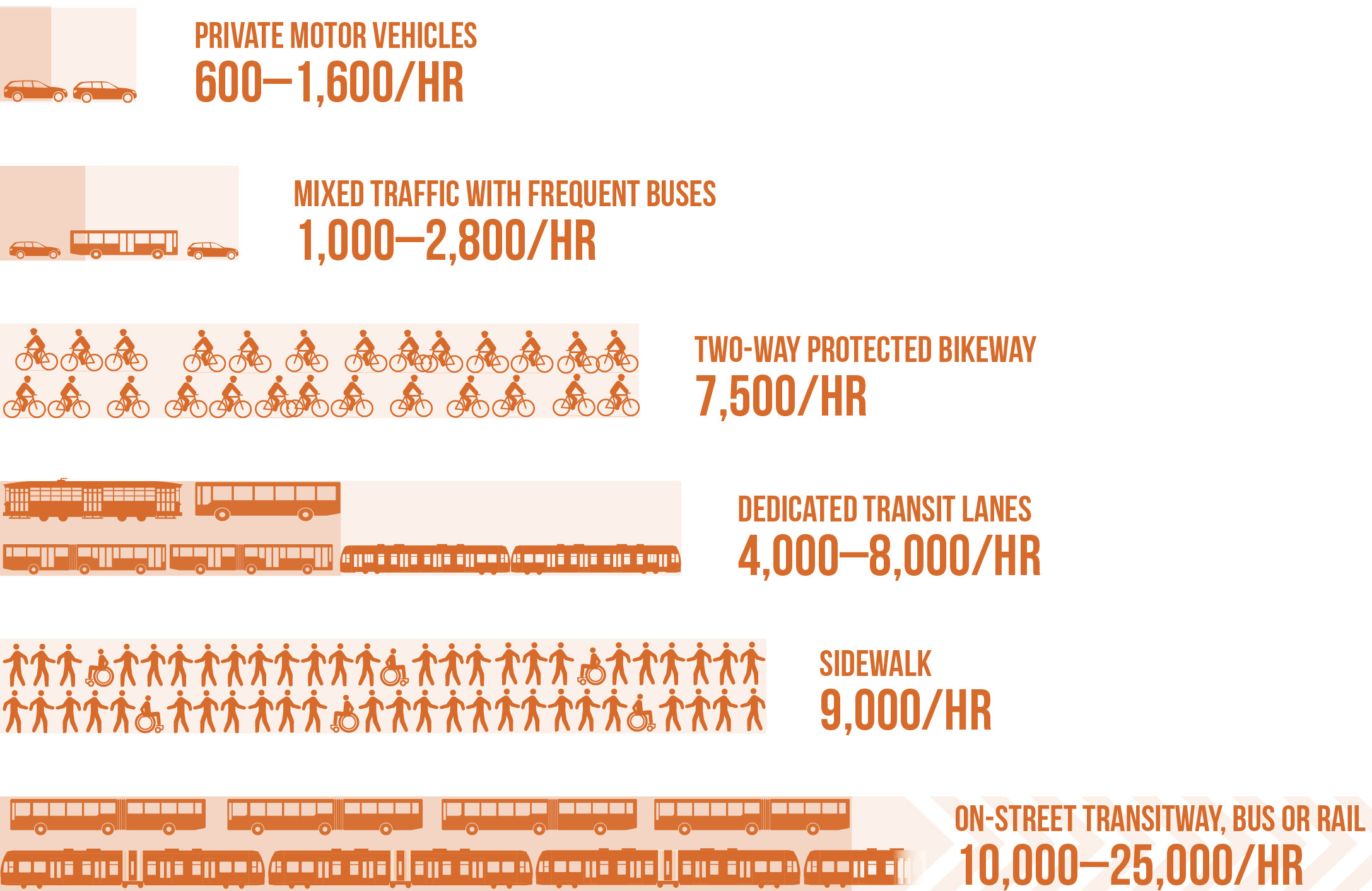
So why do we have 28,000 miles of car lanes and just 23 miles of light rail? Trains are expensive. Minneapolis' ongoing effort to build just 14.5 miles of new track is projected to cost $2.74 billion (source). Even accounting for the cost of cars, this is 2-3 times the cost of similar capacity road miles. (Minneapolis' car lanes COULD carry 45 million people in cars. The same number of people could travel on just 1,800 miles of train track. Those 1,800 miles of track would cost 2-3 times as much as 28,000 miles of car lanes. Approximately.) That's a tough sell. But consider the economic impact of replacing just half of our roads and parking lots with train tracks. We could reclaim 17 square miles of our city. That's enough space for 45,000 houses/apartments (source) and 113,000 people (source), economic engines spending and making money in our city, supporting businesses, paying taxes. When it comes to the cost of operation, mass transit wins every time. Turns out the average cost of owning a car is $10,700 per year (source). The cost of unlimited Metro Transit rides in Minneapolis is $1,440 per year (source). Of course, public transit is subsidized. Rider fares don't cover all of the costs of operating our trains and buses. And gas taxes don't cover all of the costs of maintaining our roads. That isn't factored in here. The bottom line is this: cars are not an efficient way to transport people and paving our cities is no longer an efficient way to drive economic activity. American transportation systems are inefficient and over-consume our land because they were redesigned in the 1950s to move cars. They need to be redesigned again to move people. Because cars and people are not the same thing. What can we do to reduce pavement and make space for people? Support initiatives to reform zoning regulations. Specifically, work to eliminate parking minimums (as Minneapolis has done) so that parking lots can be replaced with housing units. And of course, choose to reduce car miles by getting on the bus, train, or bike. (Many of the calculations provided here use averages and back of the envelope math which works pretty well and gives a broad picture. But we would love to see your math and, if it paints a better picture, we will update The Numbers here.) |

You are my Density |

DENSITY Density restrictions cost the US economy almost a trillion dollars every year! (source) (Hint: parking lots are limiting our potential.) Urban residents already add about $20 more per hour to GDP than their suburban counterparts (source). "The median household income inside MSAs (Metropolitan Statistical Area) is $70,956; outside MSAs it is $51,616" (source). This is because urban density allows talented workers to come together easily and cheaply. Density means a contractor can house more people with fewer materials (apartments vs houses). A delivery driver can drop off more deliveries per hour. Cities mean reduced time and transportation costs. Economies of scale. More ambitious projects. And so on. Reducing single family zoning and parking minimums to further increase density would amplify this effect as well as spur development and reduce housing costs, just like it's doing in Minneapolis! I'll explain, but first we need to go to Manhattan where a square mile of city holds 35 square miles of suburbanites. (source) The cost savings of moving resources and waste (people, food, energy) to and within one square mile are significantly less than delivering those same resources across 35 square miles. Also that suburb has 35 miles of roads and telephone poles and sewers and on and on. The equivalent space in Manhattan has just 1 mile of roads and telephone poles and sewers and so on. The ongoing maintenance costs of 35 square miles of suburban infrastructure dwarfs the upkeep on city infrastructure. Also, one fire station can reach way more residents in a city than the same station in a sprawling suburb, for example. The cost savings of density are tremendous. And of course suburban development destroys 35 times as much green space. Cities are so efficient that 83% of the US lives on just 3% of our land area. Most Americans believe dense cities are bad for the planet. (source) And they are. But not nearly as bad as every other human enclave. Living in a city has a fractional impact on the environment compared to living outside of a city. That is to say that a city of a million people has a minuscule impact on the planet compared to a million people living in suburbs and rural communities. The reasons for this are similar to those that deliver lower costs to dense areas. Density also delivers lower energy use and pollution per person. Heating and cooling apartments with shared walls, for example, uses less energy than heating houses for each individual family. Again, the list goes on and on. One study showed that doubling density cuts transportation emissions in half and reduces household energy use by a third. (source) For example, suburban residents have to travel much further than city residents and usually by single-occupant carbon-spewing car. City dwellers don't have to travel as far and often use carbon-sipping mass transit...like the elevator. Yep, the humble elevator. Turns out the elevator is the most used and GREENEST mass-transit in the world! If you're a nerd like us, check out 50 Things That Made the Modern Economy's fantastic podcast on Elevators (April 2017). (Also, there is a tiny homage to the elevator in the poster above.) Back to Minneapolis. As it turns out, Minneapolis is a YIMBY pioneer when it comes to density-oriented zoning in the US. After decades of alarmist controversy, Minneapolis managed to abolish all single family home zoning and adopt policies that allow for duplexes and triplexes on all residential properties. In the United States, this is a revolutionary move. And in the 2 years following this controversial zoning change basically nothing happened. Between Jan 2020 and March 2022, fewer than 50 duplexes and triplexes were approved for lots previously zoned as R1 (single family only) (source) in a city of more than 75,000 houses (source). Not even a drop in the bucket of the almost 9,000 non-single family housing units that were approved during the same period. (source) We don't need to abandon all single family homes, but we need to do better than this. But wait, there's more! Where did those 9,000 units come from? With little fanfare, Minneapolis also eliminated parking minimums. Previously requiring one parking space for every housing unit, Minneapolis (like most of the country) was guaranteeing that each new housing project also came with shit-tons of pavement. Following the change, housing development DOUBLED and rents have FALLEN. (source) One reason for this is that a ton of land, previously reserved for storing cars, has now become available for housing people. That's density. The cry to preserve parking for businesses has been a false argument. Adding people to a city rather than cars means there are more customers and workers to support those businesses which will thrive whether customers come by car or bike or train or hovercraft, so long as they come with money. Another reason for the increased development in Minneapolis is cost savings. The average parking space adds $24,000 to a development project (that's planning, design, and construction, but NOT land acquisition). (source) A 50 unit building used to include more than $1 million in parking costs. Without the parking minimums, project prices can drop and builders don't have to build luxury apartments to recoup development costs. So what can individuals do to impact population density (and boost the economy while saving the planet on the side)? If you can't move to a building with an elevator, support initiatives that move us away from majority single family home zoning and draconian parking requirements. The Density poster above is largely based on this info graphic from the Transformative Urban Mobility Institute. (Notice how Atlanta is SO sprawled, we couldn't even fit it on the print.) 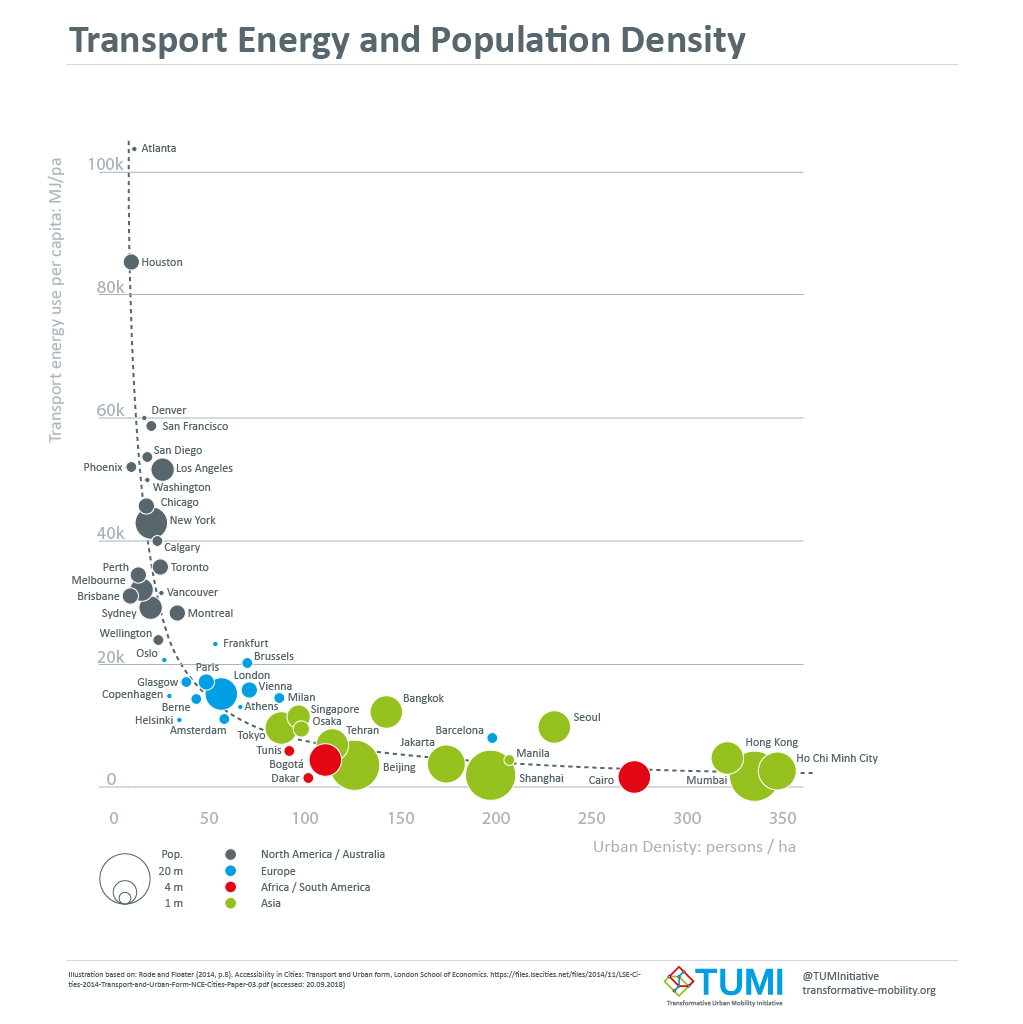
|



Cars vs the World |

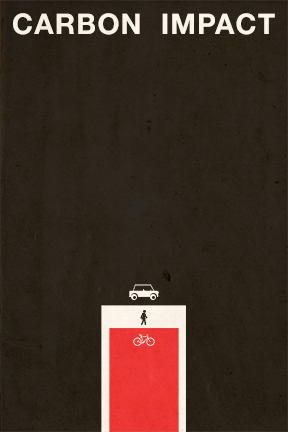
|
|

|
2.1 pounds of CO2 per mile |
|
|
||
|
|

|
0.18 pounds of CO2 per mile |
|
|
||
|
|

|
0.12 pounds of CO2 per mile |
|
|
||
|
|
||
|
|
||
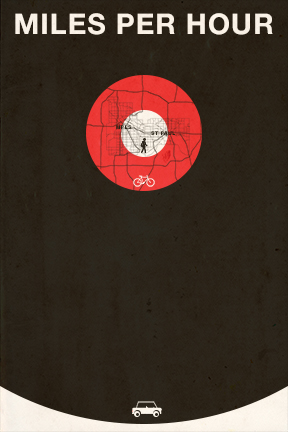
|
|

|
60 mile radius |
|
|
||
|
|

|
4 mile radius |
|
|
||
|
|

|
10 mile radius |
|
|
||
|
|
||
|
|
||
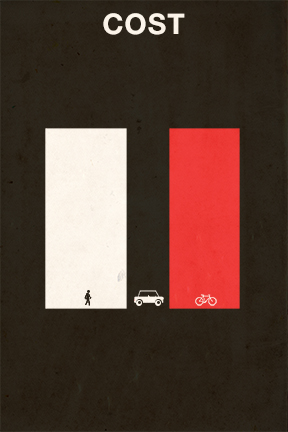
|
|

|
$727 per month |
|
|
||
|
|

|
$85 per month |
|
|
||
|
|

|
$73 per month |
|
|
||
|
|
||
|
|
||

November 27, 2019 CARBON IMPACT - Driving a gasoline powered car produces about 1 pound of carbon dioxide (CO2) per mile. (source) - Manufacturing a car also produces CO2. Over the lifetime of the average car, the manufacturing "cost" is about 1.1 pounds of CO2 per mile. (source) - Added together, this means that driving a car emits about 2.1 pounds of CO2 per mile. - This also means that driving electric cars won’t save us. Without any fossil fuel consumption, a car still "emits" 1.1 pounds of CO2 per mile because of the pollution created through manufacturing. - Riding a bicycle also uses fuel. Riding a bike burns calories. The more you exercise, the more you have to eat and food production has a CO2 impact. - The average rider produces 0.06 pounds of CO2 emissions per mile by way of consuming more food. This number goes up if that extra food is meat. It goes down if that extra food is kale. (source) - The CO2 "costs" of manufacturing a new bicycle are also about 0.06 pounds per mile. (source) - So riding a bike produces about 0.12 pounds of CO2 per mile, about 5% of a car's 2.1 pounds. - Walking burns almost 3 times as many calories per mile as bike riding. (source) - With no manufacturing "costs" walking produces about 0.18 pounds of CO2 per mile. It takes more calories to walk a mile than to bike a mile. (The manufacturing cost of shoes was not factored into these numbers.) MILES PER HOUR - A car can travel 60 miles in an hour. - A bicycle can cover 10 miles in an hour. (source) - A pedestrian can travel about 4 miles an hour. - Keep in mind that half of car trips taken by Americans are 3 miles or less (source) and that 10 miles gets you just about anywhere in Minneapolis/St. Paul. COST Nerdwallet.com has a great cost calculator for car ownership that breaks down purchase price ($372), fuel costs ($146), insurance ($98), maintenance ($99), and other miscellaneous fees ($12) on a per month basis. Put in your own data to see your car's total costs each month. Better yet, use your own data to see your BIKE'S total costs each month. - At Recovery Bike Shop we estimate the average customer spends $200 per year to commute by bicycle. - That's $500 every five years to buy a "new" bike - plus $100 per year in maintenance for a moderate commuter. - That's $1000 per five years or $200 per year. - That's $16.67 per month. - The average bike commuter consumes more calories than the average car commuter. The cost of that increased food consumption is something like $1.87 per day. (source) - This means the food costs of bike commuting are $56.10 per month. - So, the costs of owning and operating a bike are something like $72.77 per month. - Of course, your health care costs will likely go down. - Given that the "fuel" required for walking is three times that of biking on a per mile basis, we might surmise that the average walk-commuter must spend $168.30 per month on additional calories. (source) - However, it is probably less than this since a person that walks instead of bikes or drives is likely to cover fewer miles per day. We've assumed that the average walk-commuter travels something like half of the distance of a bike commuter each day. - This brings the cost of walking as transportation down to about $85 per month. Actually pretty comparable to bike-commuting. Of course this says nothing about the cost of kicks. These are the numbers reflected in the poster above. What the cost numbers don't show is that the average American drives 876 miles in a month. The average bike commuter comes no where near this. And walkers travel even less. So it is also helpful to look at these numbers on a per mile basis. - The average gasoline powered car costs about $0.83 per mile (including gas, purchase price, insurance, etc.). - 2014 census data says that the average bike commute is 19.3 minutes. (source) - The average rider travels 11 miles per hour. (source) - So the average commute is about 3.5 miles. - Twice a day is 7 miles. - Assume 5 days a week and 251 work days per year and we get 148 miles per month. - Add another 102 miles (educated guess) for errands and riding to see friends and family and probably the average bike commuter puts on something like 250 miles per month. - That's about $0.30 per bike mile. Again, most of that is in additional food consumption. |

TREES NEEDED - AAA says the average American drives 29.2 miles per day. (source) That's 61.32 pounds of CO2. (source) - There are lots of kinds of trees with varying capacity to absorb CO2 and different lifespans and such, so we assumed the average tree absorbs 1000 pounds of CO2 over the course of a 50 year lifespan: 20 pounds per year, 0.05 pounds per day. (source) - This means the average American driver needs a forest of 613 trees to absorb or offset the CO2 emitted by driving a car. - If the average cyclist rides 12 miles per day, they will produce 1.44 pounds of CO2. - A person walking 8 miles per day will also produce 1.44 pounds of CO2. - Each of these people will require 14 living trees to offset their daily carbon footprint of transportation. Please note: not all sources come up with exactly the same numbers, so we have tried to be conservative when choosing data points. Also we have made some minor tweaks when appropriate based on our own experience and our knowledge of our customers at Recovery Bike Shop. Having said that, almost all of the research agrees: driving a low occupancy vehicle produces several times the carbon dioxide pollution of riding a bike. It is worth noting the biggest exception we found. One study revealed that "fully 75 percent of a car's lifetime carbon emissions stem from the fuel it burns, not its production. A further 19 percent of that is production and transportation of the fuel, leaving just six percent for the car's manufacture." (source) Most of our research did not agree with this data point, however, if this is correct, driving an electric car would result in a dramatic reduction in CO2 emissions. The next closest source said this: "The manufacturing of a car accounts for about 30% of its carbon footprint over its lifespan." (source) Also know that this is not about killing the car or eliminating meat on our plates. At Recovery Bike Shop we drive cars and eat meat sometimes too. But the more car miles we can replace with biking or walking (or buses or trains) and the fewer meat calories we consume, the lower our carbon footprint, the less our impact on climate change, the healthier our planet will be, the healthier we will be. |

88 GALLONS PER DAY - Americans use a shocking 88 gallons of water per day just from the faucets and toilets in our homes and workplaces. Australians weigh in at a whopping 82 gallons per day. (source) - But the water we see in our sinks and bathtubs is nothing compared to the water that goes into producing the food we eat: 1,095 gallons per day. That's a gallon and a half of water every two minutes. (source) - The good news is that a little bit of effort makes a big impact. For example, switch to meatless chili and save more than a hundred gallons of water. (source) |
|
HOURS: 10-6 Sat 10-6 Sun 10-7 Mon 10-7 Tues 11-7 Wed 10-7 Thurs 10-7 Fri |

|
CLOSED: New Year's Day Thanksgiving Christmas Eve Christmas Day |
|
|
|||